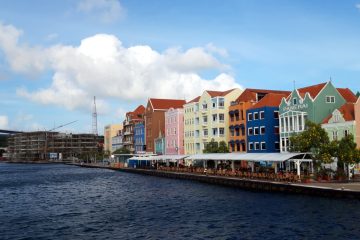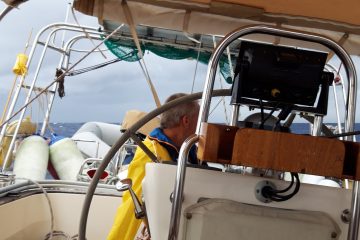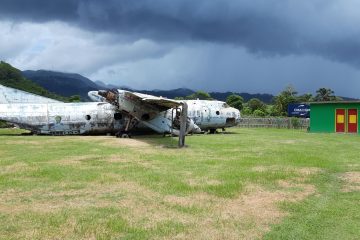After two weeks in St. Lucia we set sail to Martinique. After 3 hours we reached the first bay – St. Anne. We had a great sailing wind, BF 5, and few waves. The entire trip we were accompanied by a flock of Brown Boobies (sea birds) who snatched the flying fish jumping out of the way of the bows of the boat!
At the beginning of February my mother came with my sister and two weeks later my nephew with his girlfriend. We spent a total of almost four weeks on Martinique and sailed to virtually every bay.
Martinique is located in the middle of the Lesser Antilles framed to the north by Dominica and to the south by St. Lucia. Martinique has a total of 404,000 inhabitants and is therefore quite densely populated . Historically, Martinique was almost always a bone of contention between France and Great Britain. It was not until 1815 that Martinique was granted to France. It was also not spared from slavery. Slavery in the French Antilles was abolished only in 1794 by Victor Schoelcher (French politician), to whom several monuments in the city are dedicated.
Martinique offers in the north a lot of rain- and forest-rich mountainous country which has its peak in the volcano Montagne Pelee. A fascinating volcano we climbed later with our friends Chris & Anne. The eruption of the volcano in 1902 was one of the biggest natural disasters in the Caribbean and destroyed the capital St. Pierre completely.
So of course a visit to the volcano museum in the city of St. Pierre was not to be missed.
Tropical rainstorms, which actually accompanied us almost every day, account for such a lush vegetation that is simply fascinating. The indigenous people the Arawaks called the island “Madina” which is synonymous with flower island.
We visited several beautiful botanical gardens such as the Jardin de Balata and got to see such a variety of palms and flowers which enchanted us. Countless hummingbirds buzzed busily between each flower.
Martinique also includes countless rum distilleries that are also worth a visit, because you can see the entire production and manufacture. There’s always a chance to sample the rum and to buy at cheapers prices than in the shops.
Therefore, of course, a proper Planteuer (Rum Punch) belongs to a sundowner.
The countless white beaches with their very small villages are simply enchanting. But of course it is also very crowded with French tourists.
We also traveled a lot with the local buses, which also brought us into contact with the locals. Overall, the local population is rather poor and one wonders how they can finance the high food prices.
From the capital Fort de France we were rather disappointed. Except for a few historic houses in Creole style, the city offers rather a sad picture. Many run down houses and cheap Chinese stores everywhere.
Dominica
After the departure of my family we sailed again to St. Pierre and sailed with a good wind to Dominica. Dominica is part of the English speaking Windward Islands and has about 72,000 inhabitants. Dominica is strongly influenced by volcanism and one finds here numerous fumaroles and hot springs.
We spent one night on a buoy near the capital Roseau. However, we could not clear into the country there and we had to go further north to Portsmouth. Burning plastic garbage in the evening did not make us want to stay there any longer either.
In Portsmouth we were warmly welcomed by the PAYS people (an association of locals who look after the sailors) and immediately escorted on to the health check. Because of the Corona restrictions we had to do an antigen test and after 3 days another one. The quarantine time in between was shortened by a so called “Safe in Nature” tour. Our driver Martin made a great island tour with us and showed us not only the few Indian natives but also gave many explanations about the locals and the plant life. Also the unique chocolate factory up north was enchanting. Just a small cottage framed by cacao trees makes handmade chocolate in a variety of flavors.
The living conditions in the village of Portsmouth are rather poor and many small houses are in ruins. The only street that goes through the village is lined with brightly painted houses and the village life takes place at the daily market and the small bars. The people are incredibly friendly and grateful when you listen to their stories. Economically, the island has been repeatedly devastated by recurring hurricanes and not least by the ongoing Corona crisis of the last 2 years.
Dominica’s landscape also features an evergreen rainforest and mountain forest that ends in rugged coastlines. An incredible number of waterfalls adorn the interior. We made a trip to the Syndicate and the Spanny waterfall. Simply wonderful so a refreshing bath after a hike.
And of course we had a lot of tropical rain showers during our hikes, which soaked us to the skin. We hiked to the highest volcanic lake Boeri Lake , but unfortunately at the top lay in the clouds.
We were and are very impressed by the people and the great vegetation and will definitely come back.



